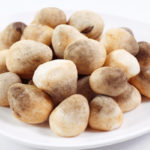What is Margarine?
Margarine is made from vegetable oils that have been hydrogenated. This process of hydrogenation causes the oil to emulsify, transforming from a liquid to a semi-solid state.
Margarine contains unsaturated fats as it is derived from vegetable oils. Medical experts suggest that these unsaturated fats help reduce bad cholesterol in the body, lowering the risk of atherosclerosis and other health issues.

Why is Margarine Considered Unhealthy?
Despite being cholesterol-free and rich in unsaturated fats, the hydrogenation process of vegetable oils converts most of these unsaturated fats into saturated fats and trans fats.
Trans fats and saturated fats are the culprits behind elevated levels of bad cholesterol in the body, increasing the risk of atherosclerosis. This is why margarine is often deemed unhealthy.
In many countries, only margarine with zero trans fat content is sold.

Notes on Using Margarine
Similar to animal-based butter, margarine adds a delightful aroma and creamy texture to your dishes. It is recommended for overweight individuals as a substitute for animal butter.
However, avoid excessive consumption as margarine still contains unsaturated fats and trans fats. The harder the margarine, the higher the trans fat content, so stick margarine is less healthy than the tub variety.
Limit your intake to no more than 14g (about 1 teaspoon) per day. Whenever possible, opt for vegetable oils instead of margarine.
Avoid heating margarine to temperatures above 150°C.

Tips for Using Margarine
Softening: If you store your margarine in the fridge, cut it into small cubes and place them in a bowl. Then, microwave until the margarine is soft but not melted.
Storage: Margarine melts easily at 35°C, so it’s best to keep it refrigerated. If left at room temperature, it will oxidize and develop a rancid odor.
Stir-frying: For stir-fries, heat the pan first, then add the margarine. Only add your ingredients when the margarine starts to bubble; otherwise, they will absorb too much margarine and become soggy instead of crispy.
Unlock Benefits of Meowington’s Meow-tastic Feline Elixir for an Exciting Feverish High
Vietnamese people’s fondness for mangoes is well-known, and they are more than just delicious tropical fruit. Not only do mangoes boast a sweet and sour taste that make them popular for both snacking and cooking, but they also offer a host of health benefits to those who consume them. Originating from Africa, mangoes are now widely grown in both Asia and Latin America.
Unveiling the Miraculous Benefits of Mushrooms
From the savory flavor they offer in dishes to their vast array of health benefits, mushrooms are a major force in the culinary world. Not only are they known as a delicious ingredient in countless recipes, but their impressive benefits can help to fight obesity, high blood pressure, and even cancer prevention.






































